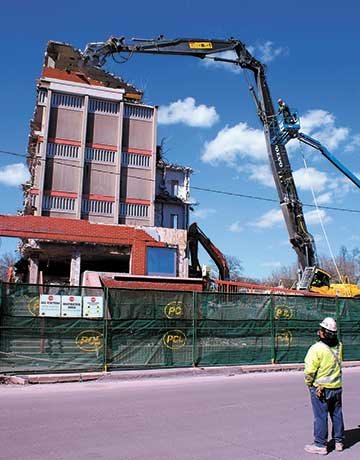The last major milestone of the Bridgepoint Hospital Redevelopment Project in Toronto’s Riverdale is an act of demolition — the elimination of the new Don Jail. PCL Constructors Canada Inc. sub-contracted the removal of the facility to Priestly Demolition Inc.
Distinguishing between the old and new Don Jail buildings has only recently become an important distinction with the development of the Bridgeport site.
The historic Don Jail, which stands west of the newer jail building, was built in 1864. It was closed in 1977 and was recently restored and repurposed as a Bridgepoint administrative building.
The new Don Jail was opened in November 1958 and featured state-of-the-art electronically-controlled cell doors and other modern amenities. The construction budget totaled $2 million — about $16.5 million adjusted for inflation.
However, inflation was already a major concern at the time. An article appearing in the November 28, 1958 Ottawa Citizen noted the high cost of incarceration. While prisoners could be housed for seven cents a day in the 1860s, the cost had skyrocketed to 45 cents that year.
The new Don Jail was emptied last November when its residents were transferred to other facilities for eventual relocation to the new Toronto South Detention Centre. The site was handed over to Bridgepoint Health in January.
The utilitarian new Don Jail was considered neither architecturally nor historically significant. Frequently criticized for overcrowding and unsanitary conditions, it was loved by few who entered its doors.
“Some of our superintendents at the site have talked to people watching the demolition who happened to have been guests of that jail,” says Sandro Marcuzzi, PCL project manager for Bridgepoint Health.
“They said it wasn’t a very pleasant place.”
Demolition began with asbestos abatement work and removal of mechanical systems, gates, and cell doors. The salvage quickly found its way to bargain website kijiji, where “Cell Doors from the Segregation Unit at the Toronto Don Jail…. The Hole…” were being offered for $525 apiece, among other correctional facility collectibles.
The building features a masonry block exterior with significant precast concrete and cast-in-place concrete components.
“Priestly is handling this with standard equipment,” says Marcuzzi. “They’re using one big high-reach excavator to take down the main structure from the fifth-floor penthouse on down, and a smaller backhoe with a hammer attachment for the more delicate work.”
The two jail buildings remained directly connected until the demolition.
“There’s a lot of meticulous hand work required for demolition where they connect with a 30-foot offset, to ensure there’s no damage to the historic Don Jail building,” says Marcuzzi. “We also want to keep vibration to a minimum, not only for the staff occupying the restored building in the offices next door, but also for the surrounding community in compliance with municipal regulations.”
Dust control measures were hampered by dry and freezing conditions earlier in the year, but as temperatures warmed, the demolition contractor was able to make full use of water misting at the site.
Traffic control measures are also in place on Jack Layton Way, the new road that now passes in front of the building.
Marcuzzi says that the jail building should be razed to near ground level by the end of April, with foundations and footings to be removed by the end of May.
Once the demolition is complete, the construction team will turn its efforts to finishing touches at Bridgepoint, including landscaping, construction of two roads — Blue Rodeo Drive and Bridgepoint Drive — and the establishment of a public park at the south end of the site.



Recent Comments
comments for this post are closed